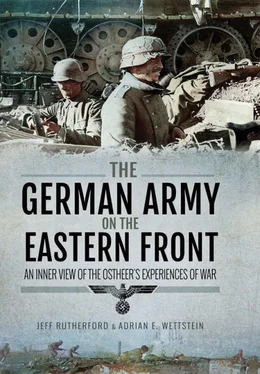Another issue of replacements emerged in the winter 1941/42 when the German army had to adapt to the changing nature of war, namely those of low-level leaders and specialists, as mentioned in the source below: [9]
The time that is available for the division after its relocation to a suitable area for refreshing will be tightly measured and must be completely utilized.
The most important preparatory work is the development of instructors, NCOs and specialists. Due to the high losses in the division especially in this regard, the accelerated commencement of this training is especially urgent.
Therefore all troop sections are to organize immediately courses for the training of NCOs, instructors and specialists . All instructors for this purpose should only be divided among completely suitable officers and NCOs, who have conspicuously proven themselves and preferably have some success in this field. The lack of suitable teaching personnel makes it necessary to consolidate the training courses in the panzer regiment, the artillery regiment, and the rifle regiments as well as the rifle brigade. This brings with it the advantage of the standardization of training.
As long as the teachers belong to the front-line sections of the division, their withdrawal is to be immediately requested at the division. […]
For the selection of the course participants , proving themselves before the enemy is above all decisive. […]
A duration of some 4 weeks is initially foreseen for the training courses. […]
By 12.1.42, the Rifle Brigade 8, Panzer Regiment 10, Artillery Regiment 80, Tank Engineer Battalion 59, Anti-tank Battalion 43, Tank Signal Battalion 84, Light Anti-aircraft Battalion 92 have to report to the division: a) the place where courses are held, b) the date of commencement, (c) the [personnel] strength of the courses.
By 16.1.42, the training plans have to be submitted to the division.
To rapidly provide the necessary low-level leaders as well as specialists, the German military leadership reacted in its typical manner, namely by decentralizing the process. Instead of building up courses at home in the Replacement Army, which was already overstrained by the demands for more recruits and its own expansion, frontline units should choose men that had proven themselves in the last month under front conditions and train them right behind the front. This saved travel time, which could easily take several weeks for the men to travel back and forth, as well as administrative work. It also had the advantage of instituting a warlike training that fulfilled the demands of the frontline units. While these initial courses in winter 1942 were improvised, they were quickly institutionalized in most divisions, often in the so-called divisional combat school. The task of the combat school was described as follows: [10]
1) The combat school’s objective is the development of independently acting, clear thinking, versatile, decisive and energetic NCOs, whose character paired with passion and technical as well as small tactical skills to convince and electrify subordinates and is example to them.
2) In addition to the use of their own weapons, all NCOs are to learn to cooperate with the heavy weapons that fight with them. Here, especially NCOs of the heavy weapons are to train in the flexible control of fire and in the rapid forming of fire concentrations. The NCOs of the Grenadier companies are to learn above all the immediate exploitation of fire.
3) Candidates for platoon- and group leaders are to drill in the technical handling of weapons and equipment, in close-combat and destroying tanks and in the giving of commands, as well as be instructed in the training of subordinates.
4) To that effect, those trained in the combat school include a) especially proven Unteroffiziere to platoon leaders, b) young, inexperienced Unterroffiziere and older good Gefreite , in special cases also Grenadiers, to group leaders, c) young, inexperienced Unteroffiziere and Gefreite of the machine gun, infantry gun and ATG companies to commanders of their weapons and group leaders.
At a divisional level, only the lowest level of leadership – the NCO – was trained. But as one can see from the tasks they were responsible for, NCOs had very different roles in the German army than in most other armies of the time, especially in tactical leadership. Officers, primarily company and battalion commanders, were trained in courses at Army or Army Group level, also a newly introduced innovation begun in winter 1942.
These two developments – the need for additional training for newly arriving recruits and the decentralized training of low-level leaders – as well as the need for training with newly introduced weapons, made training capabilities in the field units necessary. The divisional combat school was one such step, while others were taken in the field replacement battalion. It was the field replacement battalion that finally became the training facility for divisions in the east, as the following source shows: [11]
1) Purpose of field replacement battalions:
The field replacement battalion is the ‘field training battalion’ and at the same time the personnel reserve of the Eastern army’s divisions.
With the field replacement battalion, the divisions should be given the opportunity by evaluating combat experiences to:
A) train arriving replacements to become full-fledged Eastern fighters,
B) train group and platoon leaders for their demands,
C) Further training for the front fighters – especially through attack training – and to train specialists of all kinds.
As losses are the heaviest with the infantry and the engineers, the main task of the field replacement battalion is to train infantry and engineer replacements and sub-leaders.
To A): Newly arriving replacements, such as march companies, convalescent companies, etc., are to be trained in each division for several weeks in the field replacement battalion, as long as the combat situation allows for it, before deploying in the front. The same applies to the training of NCOs, who are supplied from the Replacement Army and are not yet suitable as a group or platoon leader as a result of their previous use. It is also not possible for the Replacement Army to fully train the replacements on automatic weapons (especially the machine gun) due to the lack of such weapons. The missing training is to be supplemented in the field replacement battalion.
To B): The formation of platoon and group leaders (sub-leader training) is of decisive importance in the present state of numerous divisions and in the continuing duration of the war. In consequence, divisional combat schools have been established in infantry divisions, light infantry divisions, and mountain divisions. The divisional combat schools are to be incorporated into the field replacement battalion. They count as a company. The commander of the divisional combat school (B-position) [12]can be used as commander of the field replacement battalion depending on suitability.
To C): Due to the duration of the positional warfare, it is also necessary to develop the older front fighters for other types of combat. In this case ‘attack training’ is of particular importance. If there are personnel reserves (leader reserve [13]) in the field replacement battalion, the same applies to them. The introduction of new weapons [and] the need for specialists of all kinds requires the implementation of special courses in the field replacement battalion. Furthermore, the field replacement battalion can be utilized to train the alarm units. All kinds of combat experiences can be evaluated by further trials in the field replacement battalion.
The structure of the field replacement battalion must therefore be adapted to the respective situation.
Читать дальше






![John Stieber - Against the Odds - Survival on the Russian Front 1944-1945 [2nd Edition]](/books/405234/john-stieber-against-the-odds-survival-on-the-russian-front-1944-1945-2nd-edition-thumb.webp)





